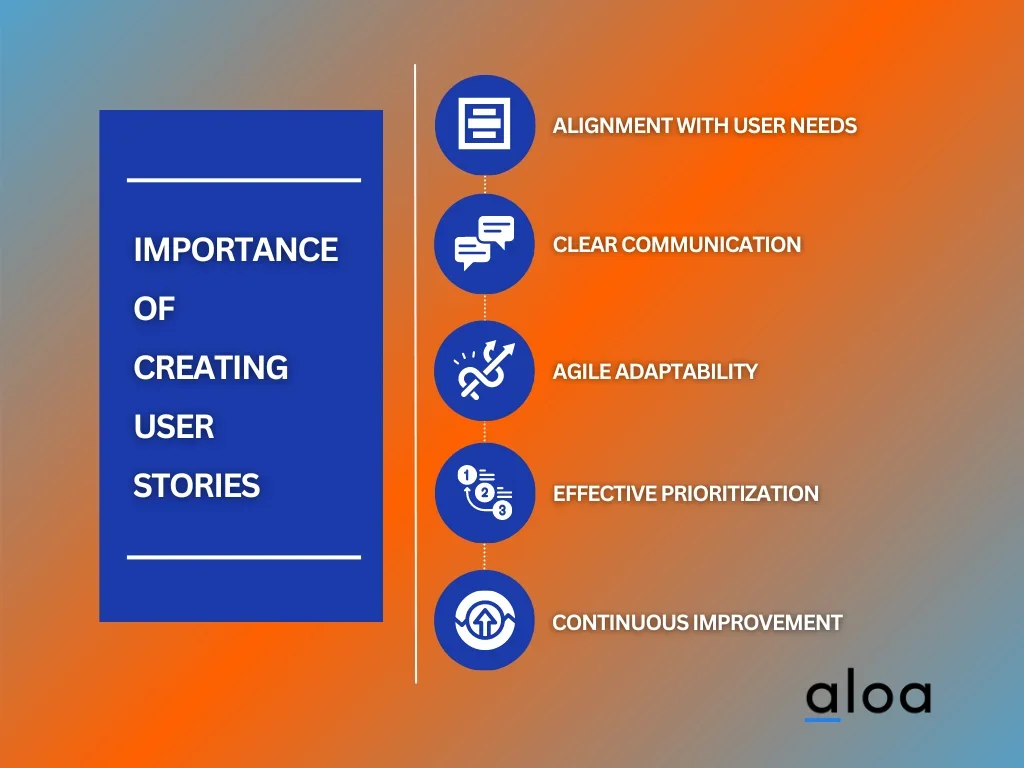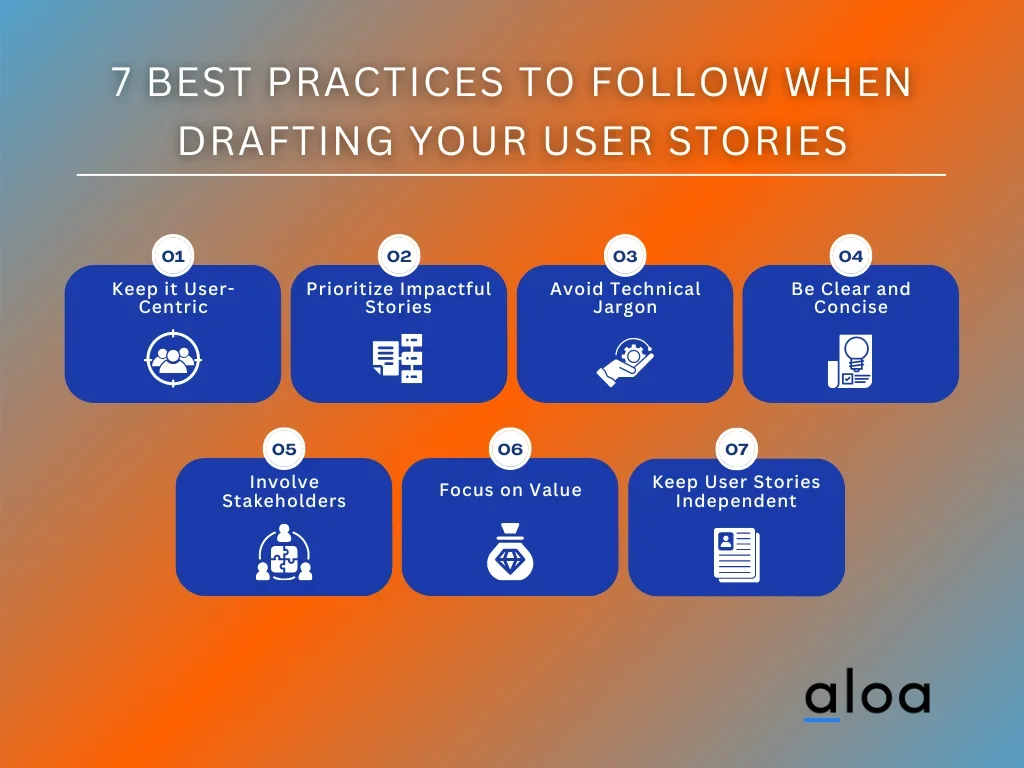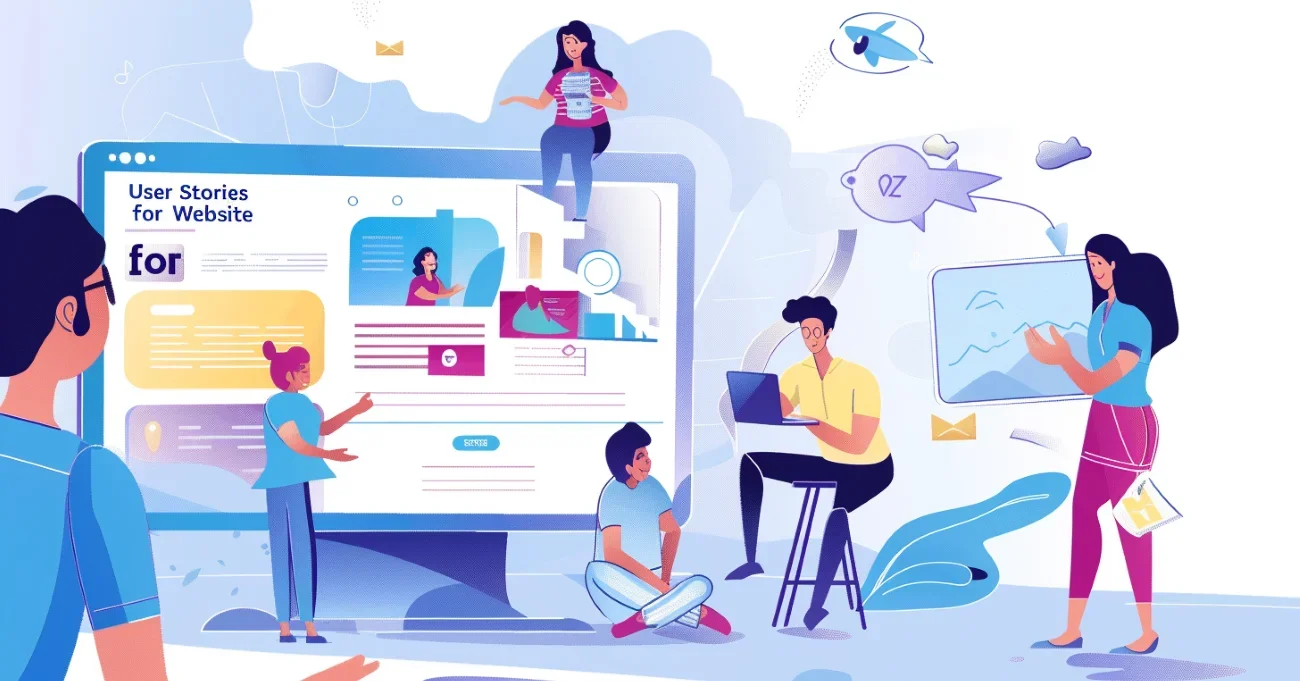Understanding how to create user stories involves crafting brief, user-centric descriptions of a software feature’s functionality written from an end user’s perspective. They outline what a user needs from the system and why they need it, focusing on the “who,” “what,” and “why” of a requirement rather than the technical details.
Product managers, product owners, and development teams commonly use a user story to ensure the final product meets user needs.
At Aloa, a software outsourcing firm, our proficient teams possess the knowledge and skills to create good user stories. Leveraging this expertise, we ensure user stories are meticulously crafted to meet our client’s needs and project objectives. Our commitment to excellence in user story creation drives successful collaborations and project outcomes.
In this guide, we’ll explore the fundamentals of how to create user stories, along with best practices to follow when drafting your user stories. In the end, you’ll understand how creating user stories contributes to successful development processes.
Let’s dive in!
How to Create User Stories: Step-by-Step Guide 2024
Exploring how to create user stories is essential for project managers and development teams aiming to capture user needs effectively. Understanding this process empowers teams to articulate user requirements in a concise and actionable format. Here are the guidelines on how to create user stories that facilitate successful software development:

Step 1: Identify User Needs
Identifying user needs involves gaining insights from the end user’s perspective on the requirements and expectations for a software product or application. This step is crucial as it ensures that the resulting user stories accurately reflect the goals and preferences of the target audience.
Here’s a helpful guide on how to identify user needs:
- Conduct User Interviews: Engage directly with end-users through interviews to gather insights into their preferences, pain points, and desired features, focusing on understanding the perspective of the end user.
- Perform User Surveys: Distribute surveys to a broader user base to collect quantitative data on preferences and behaviors specific to each type of user.
- Analyze User Feedback: Review feedback from customer support, user forums, and app store reviews to identify common issues and areas for improvement.
- Observe User Behavior: Conduct usability testing and observe how users interact with similar products or prototypes to uncover usability issues and preferences.
- Create User Personas: Develop personas representing different user segments to better understand their demographics, goals, and challenges.
Step 2: Define User Roles and Permissions
Understanding how to create user stories involves defining user roles and permissions to establish distinct levels of users’ access and responsibilities within a system or application. This practice ensures that users are granted appropriate permissions to perform their tasks effectively while maintaining robust security and data integrity.
When defining user roles and permissions, consider the following:
- Identify Distinct User Roles: Determine user roles within the system, such as administrators, managers, and regular users, to establish clear boundaries and responsibilities.
- Specify Permissions: Define specific permissions associated with each user role, outlining what actions users can perform and what data they can access.
- Implement Role-Based Access Control (RBAC): Utilize RBAC to enforce permissions, allowing administrators to assign and manage user roles quickly based on their responsibilities.
- Regularly Review and Update: Continuously review and update user roles and permissions as the system evolves and user needs change.
- Provide Documentation and Training: Offer clear documentation and training to users about their assigned roles and permissions that will promote understanding and compliance with system policies.
Step 3: Prioritize Features
In exploring how to create user stories, prioritizing features is about determining the order in which features will be developed and implemented in a software product or application. This step is essential to ensure that resources are allocated effectively and that the most valuable functionality is delivered to users first.
Some key factors when prioritizing features include:
- User Impact: Evaluate the potential impact of each feature on the end-user experience and overall product value.
- Business Value: Consider the strategic goals and objectives of the project to prioritize features that align with business priorities and drive success.
- Technical Complexity: Assess the feasibility and complexity of implementing each feature to determine the development order.
- Dependencies: Identify any dependencies between features and prioritize them accordingly to ensure smooth development and deployment.
- Market Demand: Consider market trends, competitor offerings, and user feedback to prioritize features that address current market needs and demands.
Step 4: Include Acceptance Criteria
Including acceptance criteria in user stories defines specific conditions that must be met for a user story to be considered complete and satisfactory. This ensures that the product development team and stakeholders who want to know how to create user stories clearly can understand what constitutes its successful implementation.
To execute this step successfully, consider these guidelines:
- Define Clear Criteria: Clearly outline the conditions that need to be fulfilled for the user story to be accepted as complete.
- Be Specific: Provide detailed descriptions of the user story’s expected behavior, functionality, and outcomes.
- Use Measurable Metrics: Include measurable criteria that can be objectively evaluated to determine if the user story has been successfully implemented.
- Align with User Needs: Ensure that the acceptance criteria reflect the requirements and expectations of the end-users.
- Collaborate with Stakeholders: Involve stakeholders, including product owners and end-users, in defining and refining the acceptance criteria to ensure they accurately represent the desired outcomes.
Step 5: Discuss REST API and RESTful API Integration
Discussing REST API and RESTful API integration involves determining how an application will interact with RESTful services to retrieve or manipulate data, a discussion that involves the entire team. This step is crucial as it ensures seamless communication between different parts of the software system and external services that will enhance new products’ functionality and user experience.
Here are the key points to consider when discussing REST API and RESTful API integration:
- Identify Endpoints: Determine the specific REST API and RESTful API endpoints that the application needs to interact with to fulfill its requirements.
- Define Methods: Specify the HTTP methods (such as GET, POST, PUT, DELETE) that perform operations on the API endpoints.
- Handle Authentication: Determine the authentication mechanism (such as API keys and OAuth tokens) required to securely access the REST API and RESTful API.
- Consider Data Formats: Decide on the data formats (such as JSON and XML) that will be used to exchange data between the application and the REST API and RESTful API.
- Handle Errors: Plan how to handle errors and exceptions that may occur during API integration to ensure robustness and reliability.
Step 6: Collaborate with Stakeholders
Learning how to create user stories involves collaborating with stakeholders such as product owners, end-users, and developers. This collaborative approach ensures user stories accurately reflect user needs, align with project goals, and foster a sense of ownership and buy-in among stakeholders.
Let’s explore these key considerations for a meaningful collaboration:
- Identify Key Stakeholders: Determine the individuals or groups with a stake in the project’s success, including product owners, end-users, and developers.
- Engage Stakeholders Early: Involve stakeholders from the beginning of the user story creation processes to gather insights, validate assumptions, and clarify requirements.
- Encourage Open Communication: Foster an environment of open communication and collaboration among stakeholders to facilitate the exchange of ideas and feedback.
- Iterate Based on Feedback: Incorporate feedback from stakeholders into the user stories, iterating and refining them as needed to ensure alignment with project objectives.
- Seek Consensus: Work towards reaching a consensus among stakeholders on the content and priorities of the user stories. This will ensure a shared understanding and commitment to the project goals.
Step 7: Review and Iterate
When learning how to create user stories, reviewing and iterating is important. This process involves regularly examining and refining user stories to accurately reflect the project’s requirements and goals. Start by gathering feedback from stakeholders, including developers, designers, and end-users, to validate the effectiveness of the user stories.
Consequently, analyze this feedback to identify areas for improvement and make necessary adjustments to the user stories accordingly. Take time to iterate on the user stories based on the feedback received, refining them to align with project objectives and user needs.
More importantly, consistently review and iterate on user stories throughout the development process to adapt to changing requirements and deliver a product that meets user needs and exceeds expectations.
Importance of Creating User Stories
Understanding how to create user stories is important for project managers, guiding them in effectively capturing user needs for successful project outcomes. Below, we’ve outlined the importance of incorporating user stories into the development process.

Alignment with User Needs
User stories ensure that software development efforts are aligned with the needs and goals of end-users. Therefore, understanding how to create user stories empowers teams to accurately capture and prioritize user requirements. This ensures that the developed software effectively addresses user needs and enhances user satisfaction.
Clear Communication
Knowing how to create user stories enables a whole team to communicate user requirements clearly and concisely, thereby facilitating a better understanding throughout the development process. As a common language between stakeholders, including project managers, developers, designers, and clients, user stories ensure effective communication and collaboration.
Agile Adaptability
User stories are an essential component of agile methodologies that enable iterative and incremental development. Incorporating the knowledge of how to create user stories allows teams to break down requirements into manageable chunks, deliver valuable increments of functionality quickly, and adapt to changing user needs and market dynamics.
Effective Prioritization
User stories facilitate effective prioritization of development tasks based on user value and business impact. Understanding how to create user stories guides teams in defining clear acceptance criteria. It also helps prioritize user stories based on importance, which leads to efficient resource allocation to deliver the most valuable functionality first.
Continuous Improvement
User stories support a culture of continuous improvement by providing a framework for feedback and iteration. Applying the knowledge of how to create user stories enables teams to regularly review and refine user stories based on user feedback and evolving project requirements. This drives continuous enhancement of the software product that ensures long-term success and customer satisfaction.
7 Best Practices to Follow When Drafting Your User Stories
For project managers and developers who already know how to create user stories, implementing best practices is essential for meeting user needs and achieving project success. Let’s explore the 7 best ways to follow when drafting compelling user stories.

Keep it User-Centric
Keeping user stories user-centric is a fundamental best practice in the user story creation process that emphasizes the importance of focusing on the needs and goals of end-users. It involves actively involving end-users in the requirements-gathering process through interviews, surveys, and user testing sessions.
In prioritizing user needs and preferences, product teams can ensure that user stories accurately reflect user expectations and provide genuine value to end-users. This approach helps in crafting user stories that are concise, relevant, and meaningful, which leads to higher user satisfaction and adoption of the software product.
Prioritize Impactful Stories
Prioritizing impactful stories determines how user stories will be addressed based on their importance and value during development. This practice ensures that the most critical features are delivered first to maximize the product’s impact and optimize resource allocation.
Consider the following areas on how to prioritize stories that impact the most:
- Focus on High-Value Features: Prioritize stories that deliver the most value, such as incorporating acceptance criteria, to users while aligning with project goals.
- Address Dependencies: Identify and consider stories with dependencies to ensure smooth development and delivery.
- Manage Scope: Pick stories that manage scope creep and maintain project deadlines. This enables more accurate scoping and planning of sprints.
- Optimize Resource Allocation: Allocate resources effectively by prioritizing stories based on available resources and timelines.
- Enhance User Satisfaction: Consider choosing stories that address critical user needs to enhance user satisfaction and product success.
Avoid Technical Jargon
When drafting agile user stories, it’s essential to be clear and concise to ensure effective communication and understanding among team members. Start by focusing on conveying the essential information without unnecessary details and keeping the user stories brief and to the point.
Additionally, use simple language that is easily understandable by all stakeholders. Clear and concise user stories help maintain focus on the desired outcomes and prevent misunderstandings during the development process. Adhering to this practice, teams can streamline communication, improve collaboration, and craft high-quality user stories.
Be Clear and Concise
In learning how to create user stories, being clear and concise is the practice of expressing ideas and requirements straightforwardly and understandably. This approach ensures that all team members easily understand user stories for effective communication and collaboration.
Here are the importance of being clear and concise in user stories:
- Prevents Misunderstandings: Clear and concise user stories help prevent misunderstandings among team members and ensure everyone is on the same page.
- Facilitates Prioritization: When user stories are clear and concise, it’s easier to prioritize them based on their importance and impact on project goals.
- Saves Time: Clear and concise user stories save time by eliminating the need for lengthy explanations or clarifications.
- Improves Efficiency: Teams can work more efficiently when using clear and concise user stories, leading to faster development cycles.
- Enhances User Satisfaction: User stories that are clear and concise result in products that better meet user needs and enhance user satisfaction.
Involve Stakeholders
One of the most critical best practices in drafting your user stories involves teaming up stakeholders from various domains. Stakeholders encompass individuals or groups with a vested interest in the project’s success, including product owners, end-users, developers or dedicated teams, and business analysts.
Engaging stakeholders early in the drafting process helps gather diverse perspectives and ensures user stories accurately capture the project’s requirements and goals. In doing so, you can foster collaboration and collective ownership of user stories that lead to a better understanding of user needs and project objectives.
Overall, regular communication and feedback loops with stakeholders throughout the drafting phase help validate assumptions, clarify expectations, and refine user stories accordingly.
Focus on Value
Focusing on value in how to create user stories involves prioritizing features that deliver the most value to users or align with project goals. This practice ensures that development efforts are directed towards delivering functionality that maximizes the benefit to the end-user or the project.
Here are the importance of focusing on value when drafting user stories:
- Maximizes Impact: Prioritizing high-value features ensures the product delivers maximum benefit to users or stakeholders.
- Optimizes Resources: Focusing on value allows teams to allocate resources efficiently by concentrating efforts on features that provide the most significant return on investment.
- Enhances User Satisfaction: Delivering high-value features improves user satisfaction by addressing critical needs or pain points.
- Drives Project Success: Prioritizing value-driven features contributes to overall success by aligning development efforts with project goals and objectives.
- Promotes ROI: Focusing on value, teams can prioritize features that generate the highest return on investment (ROI) for the organization.
Keep User Stories Independent
When drafting user stories, it’s crucial to keep them independent of each other. This means each story should be self-contained and focused on delivering value to the end user without relying on other user stories to be completed first. Additionally, independent user stories make it easier to manage and track progress, as they can be worked on and completed separately by different team members.
Avoiding dependencies between user stories further minimizes the risk of delays and bottlenecks in the development workflow. As project managers keep user stories independent, they promote a more efficient and streamlined development process that leads to faster delivery of valuable features to users.
Key Takeaway
Learning how to create user stories is essential for software development project managers and development teams. Refining this practice enables teams to effectively capture and prioritize user needs, leading to developing user-centric products that goes beyond customer expectations.
With heightened collaboration and continuous refinement metrics among stakeholders, developers, and project managers, user stories become powerful tools for guiding the development process and ensuring the successful delivery of software solutions.
Want to learn more about how to create user stories? Sign up for our email list to stay in the loop with the latest news, tips, and offers from Aloa. Explore other blogs on the Aloa blog page for more valuable content to enhance your knowledge and skills. Whether you’re a seasoned professional or just starting out, our resources are tailored to help you succeed.

